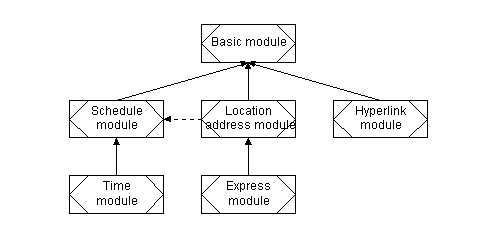 ISO/IEC
JTC1/SC34/WG4
ISO/IEC
JTC1/SC34/WG4 |
TITLE: |
Comments on the relation processing of HyTime modules |
|
SOURCE: |
Kang, Ki-Joung |
|
PROJECT: |
ISO/IEC 10744, HyTime |
|
PROJECT EDITOR: |
Godfarb, Kimber, Newcomb and Newcomb |
|
STATUS: |
Contribution |
|
ACTION: |
For information |
|
DATE: |
9 November 1998 |
|
DISTRIBUTION: |
SC34 and Liaisons |
|
REFER TO: |
|
|
REPLY TO: |
Dr. James David Mason |
 ISO/IEC
JTC1/SC34/WG4
ISO/IEC
JTC1/SC34/WG4
Date: 1998-11-10
Title: Korean Contribution to The Information Association Working Group - HyTime (ISO 10744)
(Comments on the relation processing of HyTime modules)
Contrbutor : Kang, Ki-Joung.
Research of Technical Straff.
Wireless Communication Research Lab. Korea Telecom, 17 Woomyeon-dong, Secho-gu, Seoul, Korea
Source: Korea Telecom
Project:
Status: To be reviewed and discussed at the first meeting of ISO/IEC JTC1/SC34 9-13 November 1998, Chicago, Illinois, U.S.A.
1. Introduction
Hytime(Hypermedia/Time-based Structuring Language) is a standard for specifying of the hyperlinks within or between documents and scheduling of multimedia information in time and space axis. In HyTime, such informations can be embedded in script processing instructions which perform the coding and displaying of documents and used in many applications.
Most text-based documents can be described in SGML(Standard Generalized Markup Language), which has many difficulties and limitations in coding of the objects and describing of synchronization and links of the objects.
2. Rationale
The X3v1.8M committee of ANSI(American National Standards Institute) developed SMDL(Standard Music Description Language) in 1986, which was a music development project. SMDL is a kind of 'SGML' applications and keeps a number of musical notes and information in a document.
HyTime was based on the core parts of SMDL and the special musical symbols were removed. SGML was reorganized as an application of HyTime in 1989. HyTime was revised as a language for describing high level logical structures and applying SGML to hypermedia.
3. A proposal for processing of relations between HyTime modules
HyTime, proposed in 1997, was defined five modules as base module, location addressing module, hyperlinks module, scheduling module and rendition module. But such classification had many limitations in describing of complex, composite and compound documents. This contribution suggest it should be composed of six modules as base module, schedule module, location addressing module, hyperlink module, time module, and express module and it should use at least one module among location addressing module, hyperlink and finite coordinate module in addtion to base module.
The following figure describes dependencies between modules. A solid line represents the dependency between modules and a dot line represents the dependency which occurs in case of using the property tool in module. The base module provides many tools to define objects and schedule module provides tools for referencing of object time in the coordinate axis. Besides, the location addressing module assigns addresses by the tools which provides any element or external object with ID. It is possible to generate new address from a certain address repeatedly and assign it to another object.

Fig. The relation processing of HyTime modules
The original address referenced by other objects is called a 'location source' and the address which is joined(generated) from it is called 'location chain'. Hyperlinks process the relations of many objects and the time module assigns a specific time to the objects in time. And, the express module provides a standardized method providing parts of application parameters when a document is displayed. So, When it composed the six modules, do not correspond with typical five modules, this contribution can administration easily more complex documents add time address parameters.
4. Conclusion
Hytime has played an important role in supplying an open, integrated environment for representing(describing) hypermedia. But, It has many limitations because it is composed of 5 modules. Therefore, this contribution paper supposes a new classification method which divided 6 modules.
Hytime should be revised continuously by adapting, combining and integrating of other standards like MHEG, ODA and AVIs.